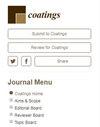电场下外部硫酸盐对混凝土侵蚀的研究
IF 2.9
3区 材料科学
Q2 MATERIALS SCIENCE, COATINGS & FILMS
引用次数: 0
摘要
有关电场促进离子快速渗入水泥混凝土的研究和应用已得到广泛探索。但利用电场促进硫酸根离子迁移的研究还很少。本文利用电场原理设计了一种新的测试方法,即在电场作用下加速硫酸盐对混凝土的侵蚀,从而测试混凝土的抗硫酸盐侵蚀能力。通过测试不同的水灰比、不同的脉冲频率、不同的龄期和不同的浸泡环境,分析了电场对混凝土抗硫酸盐侵蚀能力的影响。结果表明,在电场作用下,当水灰比为 0.3、0.4 和 0.5 时,硫酸盐侵蚀环境下混凝土的抗压强度小于传统侵蚀和水浸泡环境下的抗压强度,并随水灰比中水的增加而增加。与 14 天试验相比,混凝土在硫酸盐侵蚀环境中的抗压强度在 28 天时分别下降了 1.9%、8.6% 和 2.9%,比常规侵蚀和水浸泡的下降速度更快。硫酸盐侵蚀环境下混凝土的抗压强度在全浸泡试验和半浸泡试验中均小于常规侵蚀和水浸泡试验,且半浸泡试验方法比全浸泡试验方法更明显。比较了试验组、水组和溶液组的显微形态。从微观形态对比可以看出,电场加速了硫酸根离子向水泥混凝土中的扩散,并加速了硫酸根离子与水泥混凝土中相关成分的反应。鉴于混凝土在电场作用下抵抗硫酸盐侵蚀的要求,开发新型高效的保护材料是一个重要的研究方向。目前,市场上缺乏专门针对这种侵蚀环境的保护材料。本文为提高混凝土表面保护技术和工程实践的有效性提供了理论基础和技术支持。本文章由计算机程序翻译,如有差异,请以英文原文为准。
Study on the Attack of Concrete by External Sulfate under Electric Fields
The research on and application of electric fields to promote the rapid infiltration of ions into cement concrete have been widely explored. Still, there are few studies on the migration of sulfate ions using electric fields. In this paper, a new test method is designed using the principle of electric fields, that is, to accelerate the attack of sulfate into concrete under the action of the electric field, to test the resistance of concrete to sulfate attack. By testing different water–cement ratios, different pulse frequencies, different ages, and different soaking environments, the influence of the electric field on the sulfate resistance of concrete was analyzed. The results show that the compressive strength of concrete in a sulfate attack environment is smaller than that of conventional attack and water immersion environment when the water–cement ratio is 0.3, 0.4, and 0.5 under the action of the electric field and increases with the increase of water in the water–cement ratio. Compared with a 14 day test, the compressive strength of concrete in a sulfate attack environment decreased by 1.9%, 8.6%, and 2.9%, respectively, at 28 days, which was faster than that of conventional attack and water immersion. The compressive strength of the concrete in the sulfate attack environment during the full immersion test and the semi-immersion test is smaller than that of the conventional attack and water immersion, and the semi-immersion test method is more obvious than the full immersion test method. The microscopic morphology of the test group, the water group, and the solution group were compared. From the microscopic morphology comparison, it can be seen that the electric field accelerates the diffusion of sulfate ions into the cement concrete and accelerates the reaction of sulfate ions with the relevant components in the cement concrete. Given the demand for concrete to resist sulfate attack under the action of the electric field, developing new and efficient protective materials is an important research direction. At present, the market lacks protective materials specifically for such an attack environment. This paper provides the theoretical basis and technical support for improving the effectiveness of concrete surface protection technology and engineering practices.
求助全文
通过发布文献求助,成功后即可免费获取论文全文。
去求助
来源期刊

Coatings
Materials Science-Surfaces, Coatings and Films
CiteScore
5.00
自引率
11.80%
发文量
1657
审稿时长
1.4 months
期刊介绍:
Coatings is an international, peer-reviewed open access journal of coatings and surface engineering. It publishes reviews, research articles, communications and technical notes. Our aim is to encourage scientists to publish their experimental and theoretical results in as much detail as possible. There is no restriction on the length of the papers. Full experimental and/or methodical details must be provided. There are, in addition, unique features of this journal:
* manuscripts regarding research proposals and research ideas will be particularly welcomed
* electronic files or software regarding the full details of the calculation and experimental procedure - if unable to be published in a normal way - can be deposited as supplementary material
 求助内容:
求助内容: 应助结果提醒方式:
应助结果提醒方式:


